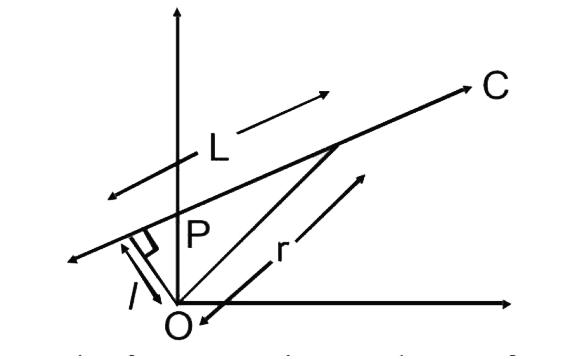A particle of mass (m) is moving with constant velocity (v). Show that its angular momentum about any point renains constant throughout the motion.Solution in Tamil
Let the particle of mass m move with constant velocity 7. As it is moving with constant velocity, its path is a straight line. Its momentum (→P=m→v) is also directed along the same path. Let us fix an origin (O) at a perpendicular distance (d) from the path. At a particular instant, we can connect the particle which is at position with a position Vector →r=¯¯¯¯¯¯OQ.
Take, the angle between the →rand→q as θ. The magnitude of angular momentum of that particle at that instant is,
L=OQpsinθ=QOmvsinθ=mv(OQsinθ)

The term (OQsinθ) is the perpendicular distance (d) between the origin and line along which the mass is moving. Hence, the angular momentum of the particle about the origin is,
L=mvd
The above expression for angular momentum L. does not have the angle. As the momentum ( p m ) and the perpendicular distance (d) are constants, the angular momentum of the particle is also constant. Hence, the angular momentum is associated with bodies with linear notion also. If the straight path of the particle passes through the origin, then the angular momentum is zero, which is also a constant.
Topper's Solved these Questions
- BOOK - FULL MARKSCHAPTER - MOTION OF SYSTEM OF PARTICLES AND RIGID BODIESEXERCISE - TEXTUAL QUESTIONS SOLVED ( MULTIPLE CHOICE QUESTIONS:)15videos
MOTION OF SYSTEM OF PARTICLES AND RIGID BODIES
- BOOK - FULL MARKSCHAPTER - MOTION OF SYSTEM OF PARTICLES AND RIGID BODIESEXERCISE - TEXTUAL QUESTIONS SOLVED ( SHORT ANSWER QUESTIOS)17videos
MOTION OF SYSTEM OF PARTICLES AND RIGID BODIES
- BOOK - FULL MARKSCHAPTER - LAW OF MOTION EXERCISE - ADDITIONAL QUESTIONS SOLVED (SHORT ANSWER QUESTIONS (3 MARKS & NUMERICALS))16videos
LAW OF MOTION
- BOOK - FULL MARKSCHAPTER - NATURE OF PHYSICAL WORLD AND MEASUREMENT EXERCISE - ADDITIONAL QUESTIONS SOLVED ( SHORT ANSWER QUESTIONS (2 MARK))20videos
NATURE OF PHYSICAL WORLD AND MEASUREMENT
Similar Questions
The centre of mass of a system of particles does not depend upon
02:34View SolutionDefine the center of mass of a body.
03:09View SolutionA block of mass 500 g is at rest on a horizontal table. What steady force is required to give the block a velocity of 200cms−1 in 4 s?
02:06View SolutionThe vernier scale of a travelling microscope has 50 divisions which coincide with 49 main scale divisions. If each main scale division is 0.5 mm. Calculate the minimum inaccuracy in the measurement of distance.
05:04View SolutionA particle of mass m moves along line PC with velocity v as shown. What is the angular momentum of the particle about P?
 05:29View Solution
05:29View SolutionShow that the angular momentum about any point of a single particle moving with constant velocity remains constant throughout the motion.
02:40View SolutionAssertion : If a particle moves with a constant velocity, then angular momentum of this particle about any point remains constant. Reason : Angular momentum has the units of Plank's constant.
02:11View Solutionदर्शाइये, कि अचर -वेग से चलते एकल कण का किसी बिंदु के परितः कोणीय संवेग उसकी समस्त गति के दौरान अचर रहता है ।
03:03View Solutionदर्शाइए कि अचर वेग से चलते हुए एकल कण का किसी बिंदु के परितः कोणीय संवेग उसकी समस्त गति के दौरान अचर रहता है ।
View SolutionA particle of mass m is moving with constant velocity v parallel to the x-axis as shown in the figure. Its angular momentum about origin O is
04:59View SolutionA particle of mass m is moving on the XY-plane along a straight line y = d, with constant velocity v. Its angular momentum about the origin
02:05View SolutionShow that the angular momentum about any point of a single particle moving with constant velocity remains constant throughout the motion.
02:58View SolutionShow that the angular momentum about any point of a single particle moving with constant velocity remains constant throughout the motion.
03:03View SolutionShow that the angular momentum about any point of a single particle moving with constant velocity remains constant throughout the motion.
02:21View SolutionShow that the angular momentum about any point of a single particle moving with constant velocity remains constant throughout the motion.
View Solution

